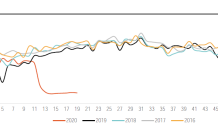The vibrancy of Chicago’s famed Loop, dotted with restaurants, bars, shops and entertainment, hinges on the return of tourists and employees whose companies occupy downtown office buildings.
The coronavirus has left once bustling streets nearly empty. On a warm spring Friday around mid-day, only essential employees could be seen on sidewalks. A lone commuter waited at bus stop. Construction crews took advantage of less traffic to make improvements.
“It’s a once-in-a-lifetime, kind of tsunami that’s come through Chicago,” said Michael Edwards, President and CEO of Chicago Loop Alliance.
Pedestrian counts are down by 80 percent, Edwards said. Typically, 370,000 people visit the Loop daily.

“It’s everybody’s neighborhood, and we’d love for them to all come back,” Edwards said.
Once the city of Chicago and state of Illinois give working professionals and companies the green light to return under their respective phased re-opening plans, the question remains whether employers will choose to come back.
Local
Under Mayor Lori Lightfoot’s plan, banking, technology, professional services and corporate offices could open as early as phase three with restrictions, such as closed break rooms and barriers between desks. Chicago is currently in phase two.
Jay Laabs is the CEO of Spaulding Ridge, an IT consulting company headquartered in the heart of the Loop. About 80 employees work in the building, and Laabs said there is no discussion right now on when they’ll return to the office.
“Literally, no one is asking me to, ‘Hey, can I get into the office?’ Not a single person,” Laabs said. “We want people to feel safe, and I feel accountable to our people and their families to not put them in harm’s way.”
Laabs said in an ideal world, the development of a vaccine would allow employees to safely come back. He said he expects some of his employees will choose to work remotely forever.
“We’re not planning on never having an office again, but we were planning on opening more physical offices across the United States because we are rapidly growing. I’m not so sure we’ll do that,” Laabs said.
Companies, big and small, are weighing the risk to their employees. Google confirmed to NBC 5 Investigates that most employees will likely work from home until the end of this year, though some offices will begin re-opening as early as June. Twitter announced last week that employees will be allowed to work remotely in perpetuity, even after the pandemic ends. And Facebook CEO Mark Zuckerberg said Thursday that half its workforce will work remotely within the next five to ten years, with many starting now.
According to a return to work study conducted by Qualtrics, two out of three people said they would feel uncomfortable returning to the workplace.
The Building Owners and Managers Association, which represents the operators of 95 percent of rentable office space in downtown Chicago, is working on new safety guidelines.
“There is no one magic pill here that’s going to solve everything,” said Michael Cornicelli, executive vice president of BOMA. “Everyone agrees that there’s a balance to be struck here between protecting the public health and getting everybody back to work and revitalizing the economies.”
Cornicelli said some options being discussed include requiring markings on the floor of lobbies to allow for social distancing, staggering employee arrival times and limiting daytime occupancy in buildings. He said big logistical challenges remain, such as how to space out in an elevator.
“Some of these buildings have daytime populations of 2,000, 3,000, 9,000 people in the normal work day before COVID-19,” Cornicelli said. “It could take eight hours to get people up four at a time (in an elevator), whether it’s a 10-story building or a 100-story building.”
Everyone will have to adjust to a new normal, experts said.
“If you think that you’re going to go back to work on day one and all your colleagues are going to be there, and it’s going to be the same as it was four months ago, you’re mistaken. It may never be like that again,” Cornicelli said.



